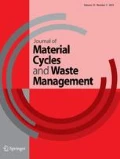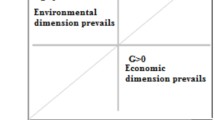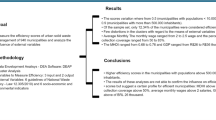Abstract
As resident awareness of environmental issues has grown, waste disposal has become an important part of urban environmental governance. Most previous research from developed countries that has sought to evaluate the technical, energy and environmental efficiencies of urban waste disposal have employed DEA. However, as there has been little research into China’s waste disposal efficiencies, this study used a dynamic DDF (directional distance function) DEA (Data Envelopment Analysis) to analyze the total waste disposal efficiencies in 23 provinces in China from 2012 to 2016, from which it was found that nine had excellent efficiencies of 1, but significant efficiency improvements were needed in 14 others.







Similar content being viewed by others
References
Rogge N, De JS (2012) Evaluating the efficiency of municipalities in collecting and processing municipal solid waste: a shared input DEA-model. Waste Manage 32(10):1968–1978
Perez-Lopez G, Prior D, Zafra-Gomez JL (2018) Temporal scale efficiency in DEA panel data estimations. An application to the solid waste disposal service in Spain. Omega 76:18–27
Halkos G, Petrou KN (2019) Assessing 28 EU member states’ environmental efficiency in national waste generation with DEA. J Clean Prod 208:509–521
Brukh R, Barat R, Mitra S (2006) The effect of waste concentration on destruction efficiency during incineration. Environ Eng Sci 23(2):383–392
Solheimslid T, Harneshaug HK, Lümmen N (2015) Calculation of first-law and second-law-efficiency of a Norwegian combined heat and power facility driven by municipal waste incineration—A case study. Energy Convers Manage 95:149–159
Tsai WT (2016) Analysis of municipal solid waste incineration plants for promoting power generation efficiency in Taiwan. J Mater Cycles Waste Manag 18(2):393–398
Petridis K, Dey PK (2016) A DEA/Goal programming model for incineration plants performance in the UK. Waste Manag Resour Util 35:257–264
Kuusik A, Pachel K, Kuusik A (2016) Assessment of landfill wastewater pollutants and efficiency of different treatment methods. Proc Estonian Acad Sci 65(4):452–471
Martorana R, Capizzi P, D’Alessandro A (2016) Electrical resistivity and induced polarization tomographies to test the efficiency and safety of the new landfill of Bellolampo (Palermo, Italy). BOLLETTINO DI GEOFISICA TEORICA ED APPLICATA 57(4):313–327
Bae J (2018) Evaluation of power generation efficiency and GHG reduction effect in municipal waste incineration facilities—enhancement of waste heat recovery capability. New Renew Energy 14(3):20–29
Gun PC (2018) A study on improvement measures of energy recovery efficiency through analysis of operational status of municipal solid waste incineration facilities. J Korea Soc Waste Manage 35(8):762–769
Beylot A, Hochar A, Michel P (2018) Municipal solid waste incineration in France: an overview of air pollution control techniques, emissions, and energy efficiency. J Ind Ecol 22(5):1016–1026
Vakalis S, Moustakas K (2019) Applications of the 3T Method and the R1 Formula as Efficiency Assessment Tools for Comparing Waste-to-Energy and Landfilling. Energies 12(6):1066
Magalhaes, V., Moutinho, V., and Marques, A. Scoring method of eco-efficiency using DEA approach: evidence from European waste sectors. 2019, 4th International Conference on Energy and Environment—Bringing together Engineering and Economics.
Ayodele TR, Alao MA, Ogunjuyigbe ASO (2020) Effect of collection efficiency and oxidation factor on greenhouse gas emission and life cycle cost of landfill distributed energy generation. Sustainable Cities and Society 52:13-18
Li J, He C, Tian T (2020) UASB-modified Bardenpho process for enhancing bio-treatment efficiency of leachate from a municipal solid waste incineration plant. Waste Manage 102:97–105
Antic K, Sremacki M, Petrovic M (2019) Analysis of leachate from a non-sanitary landfill and assessment of removal efficiency of caffeine using material and substance flow analysis. Electron J Fac Civil Eng OSIJEK-E-GFOS 19:58–67
Sisani, F., Contini, S. and Di, M. F. Energetic efficiency of landfill: An Italian case study. 2016, 71st Conference of the Italian-Thermal-Machines-Engineering-Association (ATI).
Madon I, Drev D, Likar J (2019) Long-term groundwater protection efficiency of different types of sanitary landfills: Data description. Data in Brief 26:104488
Haruki K (2010) An environmental evaluation of household waste processors. Electron Commun Japan 93(7):42–52
Duan Z, Scheutz C, Kjeldsen P (2020) Trace gas emissions from municipal solid waste landfills: a review. Waste Manage 119(1):39–62
Ishimura Y, Takeuchi K (2019) The spatial concentration of waste landfill sites in Japan. Resour Energy Econ 58:101121
Charnes A, Cooper WW, Rhodes E (1978) Measuring the efficiency of decision making units. Eur J Oper Res 2(6):429–444
Banker RD, Charnes A, Cooper WW (1984) Some models for estimating technical and scale inefficiencies in data envelopment analysis. Manag Sci 30(9):1078–1092
Tone K (2001) A slacks-based measure of efficiency in data envelopment analysis. Eur J Oper Res 130(3):498–509
Chung YH, Färe R, Grosskopf S (1997) Productivity and undesirable outputs: a directional distance function approach. J Environ Manage 51:229–240
Färe R, Grosskopf S (2010) Directional distance functions and slacks-based measures of efficiency. Eur J Oper Res 200:320–322
Chen PC, Yu MM, Chang CC, Hsu SH, Managi S (2015) The enhanced Russell-based directional distance measure with undesirable outputs: numerical example considering CO2 emissions. Omega 53:30–40
Kloop, G. The Analysis of the efficiency of production system with multiple inputs and outputs, 1985, University of Illinois at Chicago. Industrial and Systems Engineering College.
Malmquist S (1953) Index numbers and indifference surfaces. Trabajos de Estadistica 4:209–242
Färe R, Grosskopf S, Norris M, Zhang Z (1994) Productivity growth, technical progress, and efficiency change in industrialized countries. Am Econ Rev 84(1):66–83
Färe R, Grosskopf S (1996) Productivity and intermediate products: a frontier approach. Econ Lett 50:65–70
Nemoto J, Goto M (1999) Dynamic data envelopment analysis: modeling intertemporal behavior of a frim in the presence of productive inefficiencies. Econ Lett 64(1):51–56
Nemoto J, Goto M (2003) Measurement of dynamic efficiency in production: an application of data envelopment analysis. J Prod Anal 19(2–3):191–210
Sueyoshi T, Sekitani K (2005) Returns to scale in dynamic DEA. Eur J Oper Res 161(2):536–544
Amirteimoori A (2006) Data envelopment analysis in dynamic framework. Appl Math Comput 181(1):21–28
Tone K, Tsutsui M (2010) Dynamic DEA: a slacks-based measure approach. Omega 38:145–156
Zhou P, Ang BW, Wang H (2012) Energy and CO2 emission performance in electricity generation: a non-radial directional distance function approach. Eur J Oper Res 221:625–635
Zhang N, Zhou P, Choi Y (2013) Energy efficiency, CO2 emission performance and technology gaps in fossil fuel electricity generation in Korea: a meta-frontier non-radial directional distance function analysis. Energy Policy 56:653–662
Hu JL, Wang SC (2006) Total-factor energy efficiency of regions in China. Energy Policy 34:3206–3217
Funding
This research is supported by National Natural Science Fund in China, No. 71773082; Sichuan Science Project, No. 2020JDR0079; The Fundamental Research Funds for the Central Universities (Grants No. SCU-BS-PY201016).
Author information
Authors and Affiliations
Corresponding author
Ethics declarations
Conflict of interest
The authors declare that they have no conflict of interest.
Additional information
Publisher's Note
Springer Nature remains neutral with regard to jurisdictional claims in published maps and institutional affiliations.
Rights and permissions
About this article
Cite this article
Li, Y., Cen, H., Chiu, Yh. et al. Waste landfill plant and waste disposal plant efficiencies in China. J Mater Cycles Waste Manag 23, 922–936 (2021). https://doi.org/10.1007/s10163-021-01178-8
Received:
Accepted:
Published:
Issue Date:
DOI: https://doi.org/10.1007/s10163-021-01178-8




